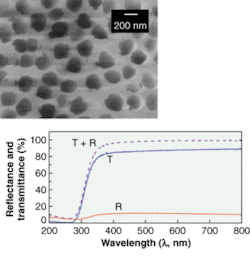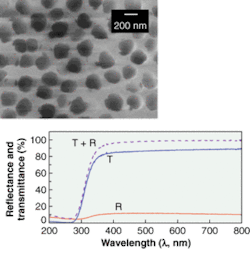Physicists at the Consejo Superior de Investigaciones Científicas (CSIC; Madrid, Spain) and the University of Delaware (Newark, DE) have demonstrated that metallic nanowires embedded in a dielectric matrix can be used to produce designer photonic-bandgap materials. Not only are the composite materials both easy and inexpensive to make, but—because the range of wavelengths they stop is dependent both on the size and distribution of the wires—the bandgap produced can be tuned to a given specification. Interestingly, the metal wires in these composites do not have to be aligned in a perfect photonic-crystal-type array. The researchers say this finding, now demonstrated experimentally, directly contradicts claims that the randomness in such structures would destroy the desired bandgaps.
We are accustomed to thinking of photonic-bandgap materials as complex gratings of various kinds and dimensions in which diffracted and/or reflected light from its periodic structures interferes to produce strong reflections for some wavelengths and transmission for others. Though this approach has been successful, particularly in producing relatively long-wavelength photonic crystals, it has proved difficult to make devices at optical wavelengths because of the small feature sizes involved.
The new work involves a different approach. Led by Nicolás García, director of the CSIC Laboratory of Physics of Small Systems and Nanotechnology, the Spanish researchers modeled the way the permittivity of metals and dielectrics can be combined to optimize their properties. Metals are photonic-bandgap materials, for instance, in that they have negative permittivity for some wavelengths (reflecting them) and positive for higher wavelengths (letting them pass). The problem is that, even at the allowed wavelengths, energy losses are very high.
By combining metals with dielectrics, however, the permittivity of the composite can be tailored as needed and the energy losses kept to a minimum, creating an insulating optical metal. Last year the team showed theoretically that the effective permittivity was not only dependent on the relative volumes of the two materials within the matrix, but also on the width and spacing of the metallic nanowires.1 Using finite-difference time-domain methods (also used for calculations related to photonic crystals), they showed how, for the same metal-to-dielectric ratio, changing the wire spacing could vary the transmission and create photonic band gaps.
The team recently fabricated this kind of nanostructured composite using an alumina membrane patterned with pores of the desired size.2 These pores were then filled with copper through electrodeposition, producing 6-µm-long wires inside the matrix. As expected, a clear transmittance gap between 250 and 750 nm opened up with this structuring, while the reflectance of the composite remained relatively stable (see figure). These results largely agree with theory, though the reflectivity around the transmission gap is actually lower than expected. The team has suggested this may be related in part to the merging of pores and to changes in the dielectric constant at high frequencies.
García and his team believe that a more-ordered structure would produce sharper transitions; such structures, they say, should not be difficult to produce using electron-beam or focused-ion-beam lithography. However, their success with the somewhat random pore distribution in the commercially produced membranes seems to support their contention that the theory holds for disordered, as well as periodic, structures.
REFERENCES
- N. García et al., Appl. Phys. Lett. 80(7) 1120 (Feb. 18, 2002).
- N. García et al., Appl. Phys. Lett. 82(19) 3147 (May 12, 2003).

